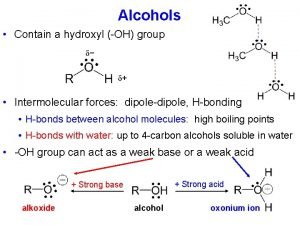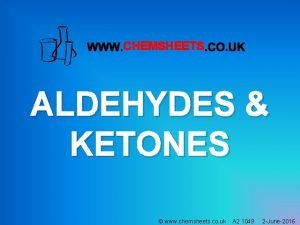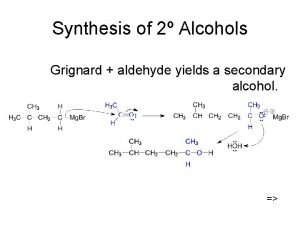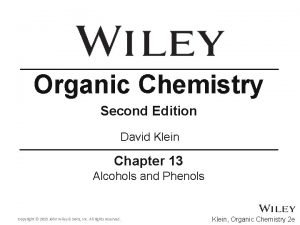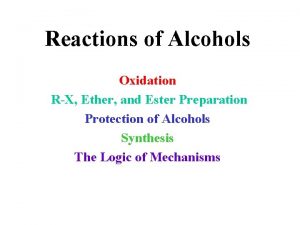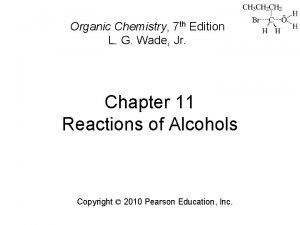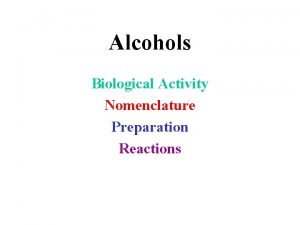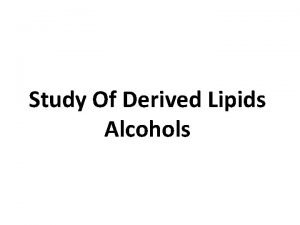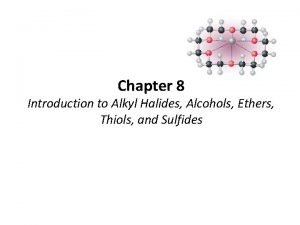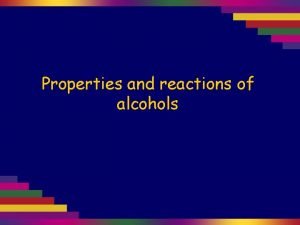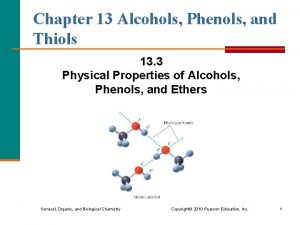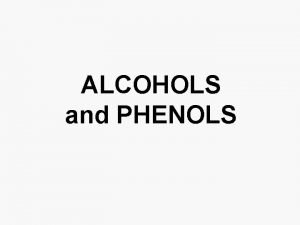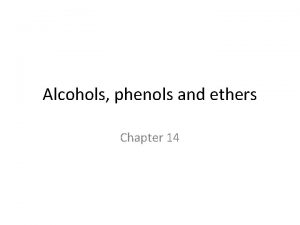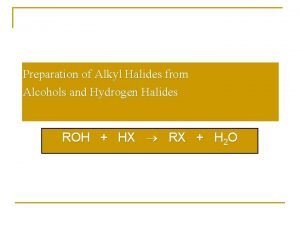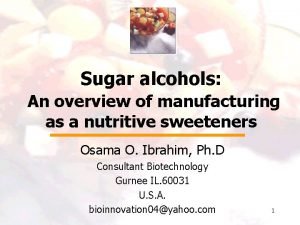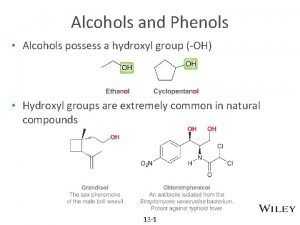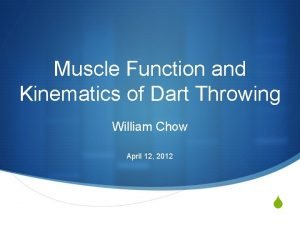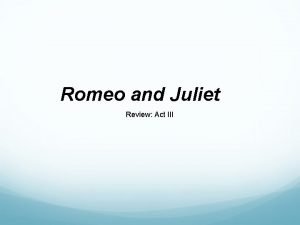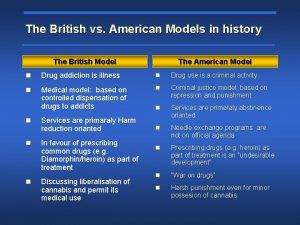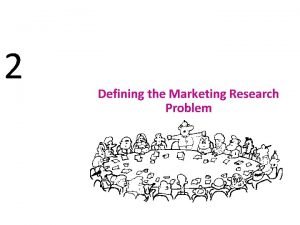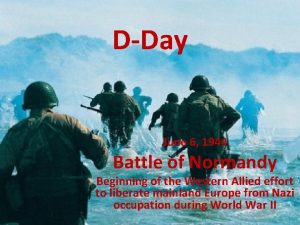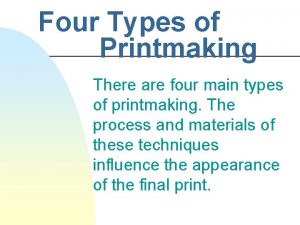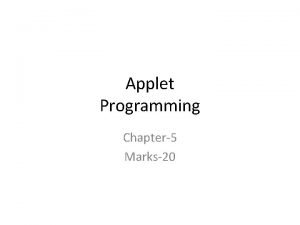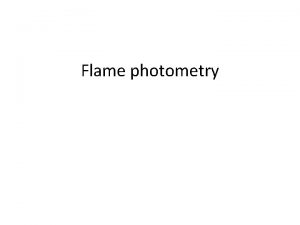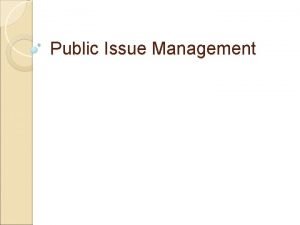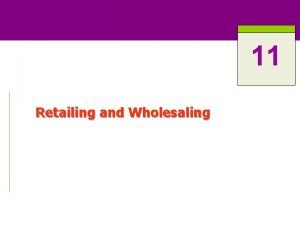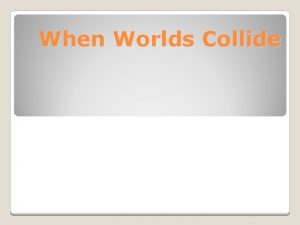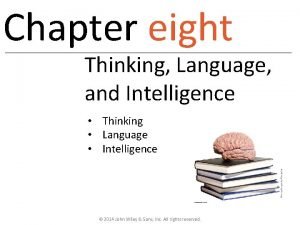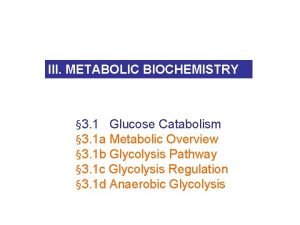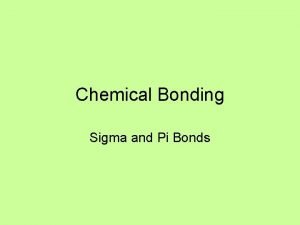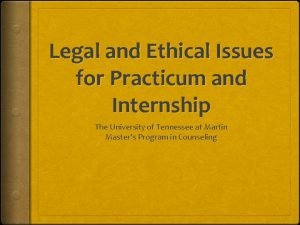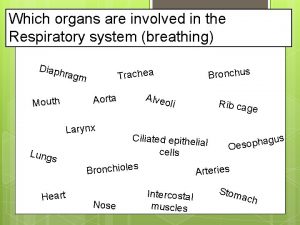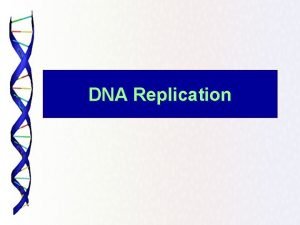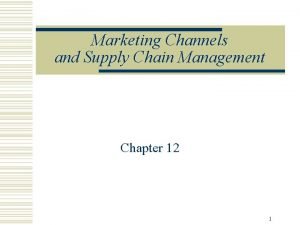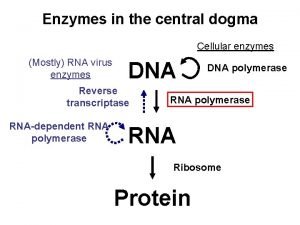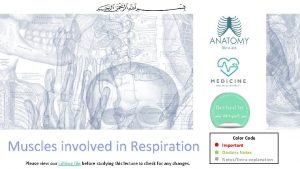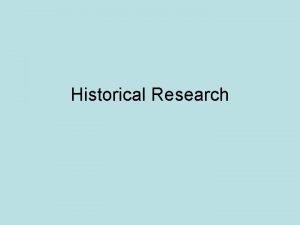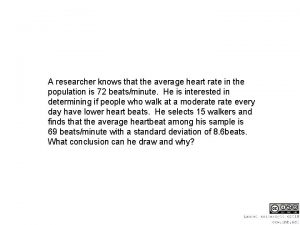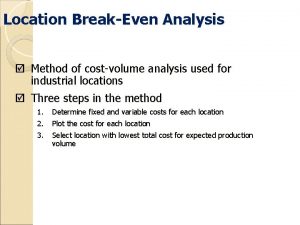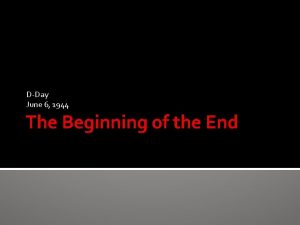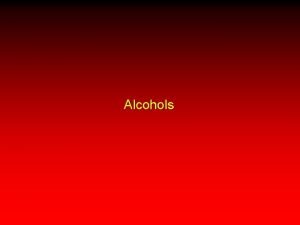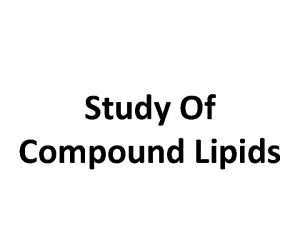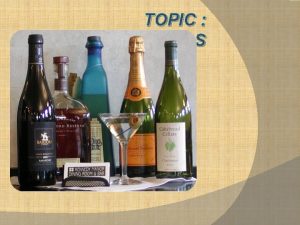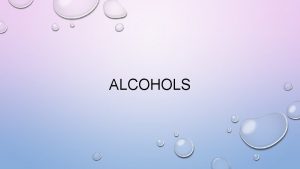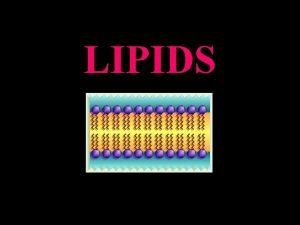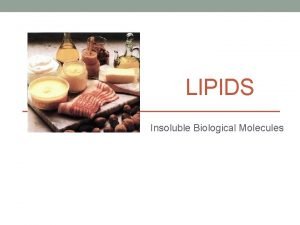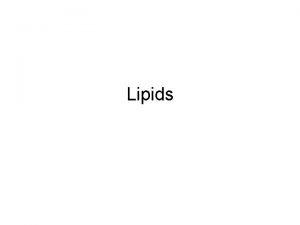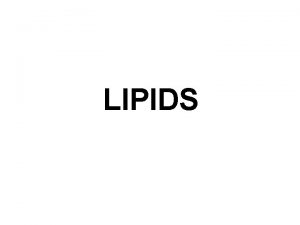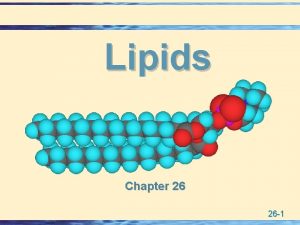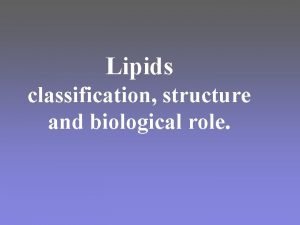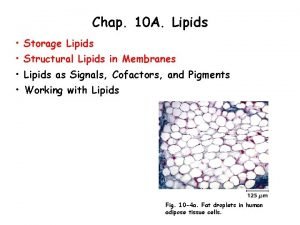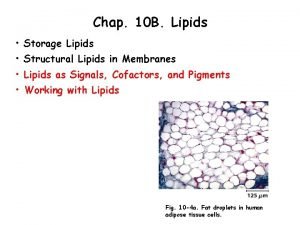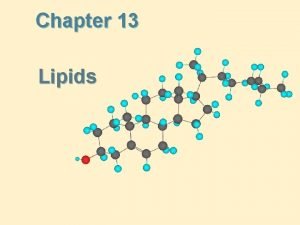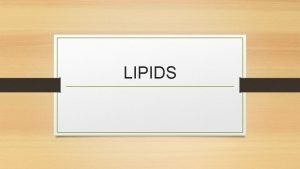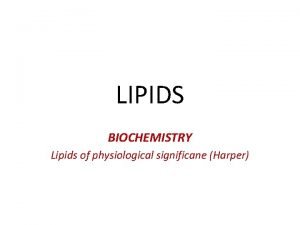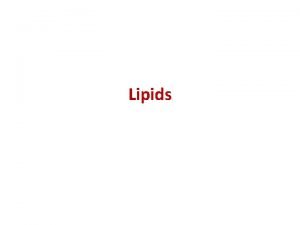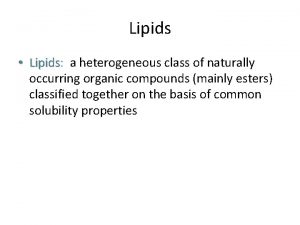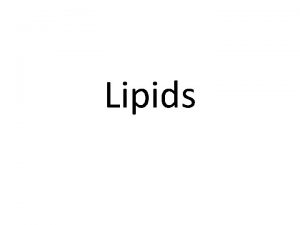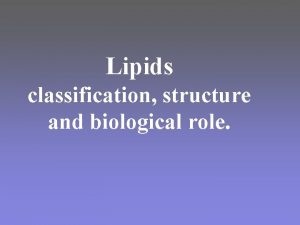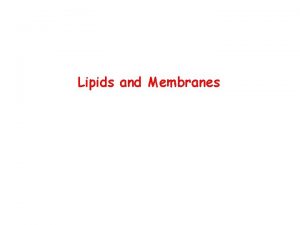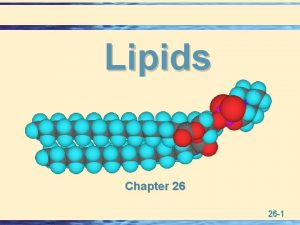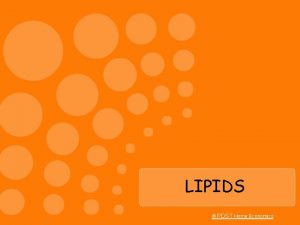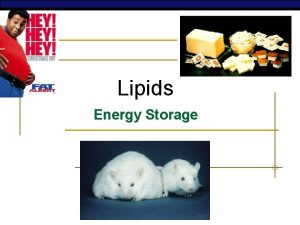Study Of Derived Lipids Alcohols Alcohols Involved In






![Glycerol/ Glycerin • Glycerol [C 3 ]is a POLYOL • Glycerol is chemically Trihydric Glycerol/ Glycerin • Glycerol [C 3 ]is a POLYOL • Glycerol is chemically Trihydric](https://slidetodoc.com/presentation_image_h/ecfba3f777c80da4f88df61128d26bb8/image-7.jpg)




























































- Slides: 67

Study Of Derived Lipids Alcohols

Alcohols Involved In Lipid Structures

3 Alcohols Involved In Various Forms Of Lipids 1. Glycerol (C 3 -Trihydric Alcohol) 2. Sphingol/Sphingosine (C 18 -Dihydric Alcohol) 3. Cholesterol (C 27 -Monohydric Alcohol)

Alcohols Of Lipids Are Classified As Derived Lipids

Glycerol is a Derived Lipid Obtained from Hydrolysis of Simple and Compound Lipids

![Glycerol Glycerin Glycerol C 3 is a POLYOL Glycerol is chemically Trihydric Glycerol/ Glycerin • Glycerol [C 3 ]is a POLYOL • Glycerol is chemically Trihydric](https://slidetodoc.com/presentation_image_h/ecfba3f777c80da4f88df61128d26bb8/image-7.jpg)
Glycerol/ Glycerin • Glycerol [C 3 ]is a POLYOL • Glycerol is chemically Trihydric Alcohol (3 –OH groups) • Glycerol has potency to interact with 3 same or different Fatty acids.

v. Glycerol is a backbone of Glycerol based Lipids viz: v Triacylglycerol v Glycerophospholipids

Glycerol Sources To Human Body Endogenous and Exogenous Sources Glycerol Glucose

Source Of Glycerol To Human body • Glucose is responsible for biosynthesis of Glycerol in human body • Glucose transforms to Glyceraldehyde, • Glyceraldehyde on reduction forms Glycerol.

• Glycerol formed is then used for Biosynthesis of Glycerol based Lipids. • Glycerol released from hydrolysis of Glycerol based Lipids is transformed to Glucose.

SPHINGOSINE/SPHINGOL


• Sphingosine is a derived Lipid. • Obtained from Hydrolysis of Sphingolipids

• Sphingosine is a C 18, complex Dihydric, Amino alcohol. • Sphingosine is biosynthesized in human body using amino acid Serine. • Serine provides NH 2 group of Sphingosine.

• Sphingosine forms Sphingolipids /Compound Lipids with Alcohol Sphingol • Examples of Sphingolipids: • Sphingophospholipids • Sphingoglycolipids


What Is a Ceramide? • A Fatty acid linked to an amino group of Sphingosine • With an amide linkage form a Ceramide.

• Ceramide if linked to Phosphate and Nitrogenous groups forms Sphingophospholipids. • Ceramide linked to Carbohydrate moieties form Sphingoglycolipids.

Sphingosine Based Lipids

Sterols

Common Sterol And Steroids Vitamin D 3 (cholecalciferol) Cholesterol (a sterol) Testosterone (a steroid Stigmasterol (a phytosterol)

• Sterols are chemically complex, organic monohydric Alcohols. • Sterols has cyclic ring structures

• Sterols have a parent ring • Cyclo Pentano Perhydro Phenantherene (CPPP) nucleus.

Examples Of Sterols • Cholesterol (Animal Sterol) • 7 Dehydrocholesterol( Provitamin D) • Coprosterol (Excretory form Cholesterol) • Ergosterol (Plant Sterol) • Sitosterol (Plant Sterol)

Cholesterol Most abundant Sterol of Human body

Cholesterol • Cholesterol is an Animal Sterol. • Cholesterol means Solid Alcohol as it was first obtained from gall stones of bile. • Cholesterol is excreted via bile hence richly composed in bile , Gall stones.

Cholesterol Is A Derived Lipid

• Cholesterol is classified as Derived Lipid. • It is derived from hydrolysis of Cholesterol Ester (Human Body Wax).

Chemical Structures Of Cholesterol and Cholesterol Ester

Pentahydrophenantrene (Sterane)


Structure Of Cholesterol • Cholesterol is complex, cyclic, unsaturated, monohydric Alcohol. • Molecular formula is C 27 H 45 OH

• Cholesterol has parent nucleus as Cyclo Pentano Per hydro Phenantherene ring system(CPPP). • The structure of CPPP has four fused cyclic rings (A, B, C and D)

• Hexane ring A, B, C is a Phenatrene nucleus. • D ring is Cyclopentane ring.

• The Structure of Cholesterol Possess: 1. 2. 3. 4. Hydroxyl group (-OH) at C 3. Double bond between C 5 and C 6. 5 Methyl (-CH 3) groups. 8 Carbon side chain linked to C 17 of the structure.

Forms Of Cholesterol In Human Body • Cholesterol exists in two forms: –Free Cholesterol - 30% (Amphipathic form) –Cholesterol Ester - 70% (Non polar form)


Properties Of Cholesterol • Cholesterol is white or pale yellowish, crystalline , odorless compound. • Insoluble in water and soluble in organic solvents like Ether and Chloroform.

Crystals of Cholesterol Rhombic plates with Notched edges.

• Qualitative Tests For Cholesterol detection are: –Liebermann Burchard Reaction –Salkowski Reaction –Zak’s Reaction

Sources Of Cholesterol To Human Body

• Exogenous Sources of Cholesterol: –Animal Origin Food Items • Endogenous Source Of Cholesterol: –Obtained In well fed condition from Excess Glucose

Dietary Sources Of Cholesterol • Cholesterol is exclusively present in animal foods.

• The dietary rich sources of Cholesterol animal origin foods like: –Egg Yolk –Meat –Milk –Butter –Ghee –Cream

• Remember Cholesterol is absent in plant origin food items.

Endogenous Source Of Cholesterol • Cholesterol Biosynthesized in human body from Free Excess Glucose in Liver.

Transportation Of Cholesterol –Cholesterol in blood is transported by Lipoproteins: • Chylomicrons ( Dietary origin) • LDL (From Hepatocytes to Extra hepatocytes) • HDL (From Extra hepatocytes to Hepatocytes)

Occurrence and Distribution Of Cholesterol in the Body

– 70 % of Cholesterol associated with cellular components – 30 % of Cholesterol is in the Blood.

• Cholesterol is richly present in Nervous tissue Brain. • Other organs containing Cholesterol are: –Liver –Adrenal Cortex –Gonads –Intestinal Mucosal cells –Skin

Functions Of Cholesterol Depends Upon Quality and Quantity

• Cholesterol is constituent of biomembranes of cell • It give structure, shape and fluidity to them.

Effects on Membrane without Cholesterol In Cold Environment In Hot Environment Rigid/ Not Flexible Too Flexible Not Fluid Very Fluid May Get damage Not hold Shape

• Cholesterol richly present in nervous tissue and covers Myelin sheaths. • Cholesterol help in nerve impulse conduction.

• Cholesterol helps in nerve impulse transmission since: –It has high dielectric constant. –It is a poor conductor of heat and electricity.

Cholesterol Serves Precursor for Biosynthesis Of Many Steroids

Derivatives of Cholesterol • Steroids are derivatives of Sterols. • Chemical Compounds obtained from Cholesterol are termed as Steroidal compounds.

• Derivatives of Cholesterol • • Vitamin D (Cholecalciferol) Bile acids (Cholic and Chenodeoxycholic acid) Bile Salts are obtained from Bile acids. Steroidal Hormones – ACTH – Mineralocorticoids – Glucocorticoids – Sex Hormones: Androgens, Progesterone, Estrogen and Testosterone

Bile Acids and Bile Salts

Steroids Hormones

Disorders Related To Cholesterol

• Serum Total Cholesterol level of a Healthy human body is 150 -200 mg%

Hypercholesterolemia • Causes for Hypercholesterolemia • High intake of dietary Cholesterol(animal origin) is a exogenous source of Cholesterol. • Elevated endogenous Cholesterol biosynthesis when a very rich Carbohydrates is ingested. • Defect in Cholesterol transport by Lipoproteins in blood retains Cholesterol in blood.

Conditions Of Hypercholesterolemia • Diabetes mellitus • Obstructive Jaundice • Nephrotic Syndrome • Hypothyroidism

• Hypercholesterolemia leads to : – Deposits of excess of Cholesterol in blood vessels. – Atherosclerosis and atheroma /plaque formation. – Increased risk of ischemia and Myocardial infarction and Stroke.

– Cholesterol Summary – Cholesterol is exclusively found only in animals. – Exogeneous Cholesterol comes from diet – Endogeneous Cholesterol is biosynthesized by the Liver from Glucose product Acetyl. Co. A. – Cholesterol is an important component of biomembranes, steroidal hormones, bile acids and Vitamin D
 Butanone isomers
Butanone isomers Propanal + kcn
Propanal + kcn Alcohol to aldehyde oxidation
Alcohol to aldehyde oxidation Alcohols nomenclature
Alcohols nomenclature Bleach and ethanol reaction
Bleach and ethanol reaction Lucas reagent is
Lucas reagent is Na2cr2o7 mechanism
Na2cr2o7 mechanism Alcohols containing cppp nucleus
Alcohols containing cppp nucleus Naming alkyl halides
Naming alkyl halides Chlorination
Chlorination Alcohols phenols thiols and ethers
Alcohols phenols thiols and ethers Acidity of alcohols
Acidity of alcohols What is secondary alcohol
What is secondary alcohol Naming ethers
Naming ethers Preparing haloalkanes from alcohols
Preparing haloalkanes from alcohols Names of sugar alcohols
Names of sugar alcohols Secondary alcohol oxidation
Secondary alcohol oxidation Pcc with aldehyde
Pcc with aldehyde Who was involved in dday
Who was involved in dday Anatomy of throwing a dart
Anatomy of throwing a dart Why do juliet’s parents think she is sad?
Why do juliet’s parents think she is sad? British model involved with drugs
British model involved with drugs What countries were involved in world war 2
What countries were involved in world war 2 Which phases were involved in maximum green belt project
Which phases were involved in maximum green belt project Marketing problem definition
Marketing problem definition Fish reproductive system
Fish reproductive system Assay of ibuprofen practical
Assay of ibuprofen practical Output design paper
Output design paper Who was involved in dday
Who was involved in dday Four major process of printmaking
Four major process of printmaking Justice involved supportive housing
Justice involved supportive housing Steps involved in developing and running a local applet
Steps involved in developing and running a local applet Principle involved in flame photometry
Principle involved in flame photometry The process of exchanging
The process of exchanging Pt factors involved
Pt factors involved Two types of people media are
Two types of people media are A purposeful refusal to become generally involved
A purposeful refusal to become generally involved Public issue management functions
Public issue management functions Includes all the activities involved in selling products
Includes all the activities involved in selling products The opportunity analysis canvas
The opportunity analysis canvas What continents were involved in the columbian exchange
What continents were involved in the columbian exchange What are the basic steps involved in the simplex algorithm?
What are the basic steps involved in the simplex algorithm? No taxation without representation
No taxation without representation Ankle extension muscles
Ankle extension muscles Chapter 8: thinking, language, and intelligence
Chapter 8: thinking, language, and intelligence Enzyme involved
Enzyme involved Admission procedure in fundamentals of nursing
Admission procedure in fundamentals of nursing How are p orbitals involved in double bonds
How are p orbitals involved in double bonds Rizal and his party went to pagsanjan for what reason?
Rizal and his party went to pagsanjan for what reason? Professional and ethical issues during internship
Professional and ethical issues during internship Which organs are involved in respiratory system
Which organs are involved in respiratory system The principle enzyme involved in dna replication is called
The principle enzyme involved in dna replication is called Steps portfolio management process
Steps portfolio management process Mount st helens plates involved
Mount st helens plates involved Replication process
Replication process Explain the steps involved in controlling process
Explain the steps involved in controlling process Setting channel objectives
Setting channel objectives Dna central dogma
Dna central dogma What are inspiratory muscles
What are inspiratory muscles Cold war who was involved
Cold war who was involved Is great britain a country
Is great britain a country What's history
What's history American researcher who involved in getting heart rate
American researcher who involved in getting heart rate Locational break-even analysis
Locational break-even analysis 1s22s2sp63s23p4
1s22s2sp63s23p4 Fifth labor of hercules
Fifth labor of hercules How many countries were involved in wwi
How many countries were involved in wwi Who was involved in dday
Who was involved in dday
